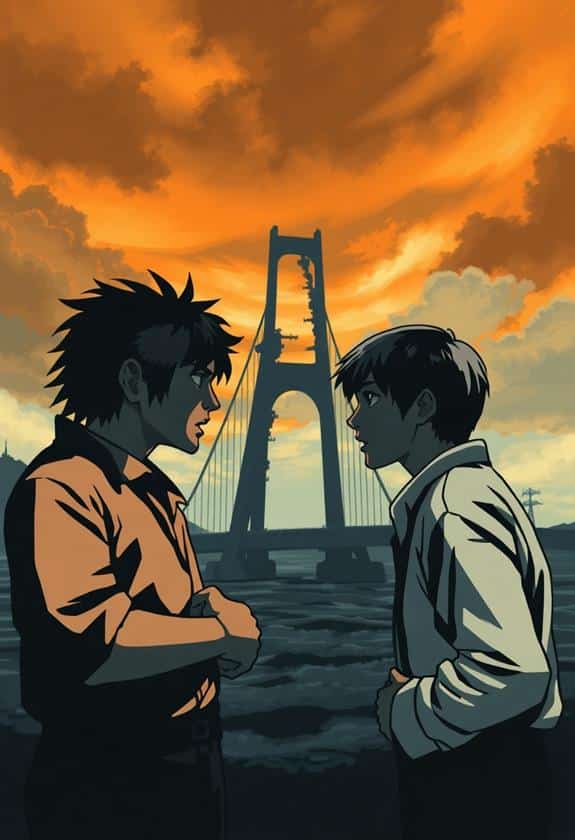Basic screenwriting structure is like the backbone of your story, guiding you and your audience through a thrilling adventure. Most scripts follow a three-act format: Act 1 sets up your characters and their world, Act 2 throws them into conflicts, and Act 3 wraps everything up with satisfying resolutions. It’s like a roller coaster ride! You’ll also use key plot points, like the inciting incident that kicks off the action, and the climax that gets everyone on the edge of their seats. Don’t worry if it feels tricky at first; there are exciting ways to make it all come together!
Key Highlights
- The basic screenwriting structure typically follows a three-act format: Setup, Confrontation, and Resolution.
- Act One introduces the characters, and setting, and establishes the world of the story.
- Act Two escalates conflict and develops characters through challenges and obstacles.
- Act Three resolves conflicts and provides closure, completing the character arcs.
- Key plot points like the inciting incident and climax enhance narrative clarity and engagement.
Understanding Screenplay Structure

Understanding screenplay structure is essential for crafting a compelling narrative that resonates with audiences. When you immerse yourself in writing, you’ll find that a solid structure can keep you on track, like a safety net beneath a tightrope walker. You don’t want to fall into the trap of wandering aimlessly; trust me, I’ve been there. Just as essential filmmaking equipment supports your production, a well-defined structure supports your screenplay.
Think of your screenplay as a journey. You want to take your audience somewhere meaningful, right? A well-structured story helps you guide them through twists and turns, ensuring they feel secure and engaged. Start with a clear setup, where you introduce your characters and their world. This is your chance to hook the reader and build trust, just like a warm introduction at a party.
Next, create conflict that challenges your characters. This doesn’t have to be scary, but it should keep viewers invested. Finally, you’ll want a resolution that ties everything together. Remember, your audience wants to feel safe, and a satisfying conclusion gives them that comfort. So, embrace the structure, and let it be your friend on this exciting filmmaking journey! You’ve got this!
The Three-Act Format

Using the three-act format is a powerful way to structure your screenplay, creating a clear path for your story to unfold. Picture it as a roller coaster: you start slow, build tension, then take that thrilling dive! In Act One, you introduce your characters and set up the world. You’ll want to hook your audience, so think about what makes your story unique. Consider incorporating elements from affordable filmmaking gear to enhance your production quality without breaking the bank.
In Act Two, things get complicated. This is where your characters face challenges that test their limits. It can feel like a maze, but don’t worry—this is where the magic happens. Share a moment when your character feels like giving up, but then finds a spark of hope.
Key Plot Points

Key plot points serve as the backbone of your screenplay, guiding your audience through the emotional highs and lows of the story. Think of them as the vital moments that keep everyone hooked. You’ve got your setup, where you introduce characters and their world—this is like laying the foundation of a cozy home. For filmmakers, capturing these key moments with the right tools can enhance storytelling, and discovering the best cameras for filmmaking enthusiasts can make a significant difference. Then comes the inciting incident, the moment that shakes things up and sets your hero on their journey. It’s that “uh-oh” moment that makes your viewers lean in closer.
Next up is the midpoint, a turning point where everything changes. It’s like when you finally realize that the monster isn’t hiding under the bed but is actually your best friend wearing a scary mask—surprising yet relatable. The climax is where all the tension peaks, and every emotion you’ve built comes to a thrilling head. Finally, you wrap it all up with the resolution, giving your audience that comforting sense of closure. They’ll leave feeling satisfied, like finishing a good book.
Character Arcs Explained

Every compelling story hinges on its characters and their journeys. Character arcs are essential because they show growth, change, or sometimes, the lack of it. Think about your favorite characters—didn’t they face challenges that made them evolve? You can create relatable arcs by considering how your characters respond to events in the story.
Here’s a simple way to visualize character arcs:
| Stage | Description | Example Character |
|---|---|---|
| Starting Point | The character’s initial state | A shy girl afraid to speak up |
| Change | The pivotal moment of transformation | She stands up to a bully |
| Growth | How they adapt and change after events | She becomes a leader in her group |
| Resolution | Final state at the story’s end | She confidently voices her opinions |
This table shows how arcs can provide depth to your characters. Remember, it’s okay to let them stumble along the way. I once had a character who flopped in every scene until I let them embrace their flaws. That’s when the magic happened! So, dive deep into your characters’ hearts and let their journeys unfold naturally.
The Importance of Conflict

Character arcs may showcase growth and change, but without conflict, those journeys would lack tension and engagement. Conflict is the spark that ignites your story, pushing characters to confront obstacles and revealing their true selves. Think of it as the seasoning in your favorite dish; without it, everything falls flat. Effective storytelling can also be enhanced by the right visuals, as seen with essential cameras for aspiring filmmakers, which can capture the emotional intensity of conflict beautifully.
Here are three reasons why conflict is essential in screenwriting:
- Drives the Plot: Conflict creates a roadmap for your story, guiding your characters through their challenges, decisions, and ultimate resolutions.
- Builds Empathy: When characters face struggles, we connect with them on a deeper level. It’s like when you root for your favorite hero in a movie; you want them to succeed against all odds.
- Enhances Engagement: Tension keeps audiences on the edge of their seats. Think of those moments when you can’t look away because you’re invested in what happens next.
Creating a Compelling Climax

A powerful climax can make or break your story, serving as the moment where all the built-up tension culminates in a dramatic confrontation or revelation. It’s that heart-pounding moment where your audience holds their breath, and everything seems to hang in the balance. To create a compelling climax, you need to guarantee that it resonates with your characters’ journeys and the conflicts you’ve developed.
One key element is stakes. Ask yourself, “What’s at risk?” When I wrote my first script, I realized that without high stakes, the climax felt flat. Here’s a quick table to help you think through some important aspects of your climax:
| Element | Description |
|---|---|
| Stakes | What does the character stand to lose? |
| Conflict | What’s the main challenge they face? |
| Emotional Impact | How will this moment affect the audience? |
| Resolution | How does this climax lead to the ending? |
| Character Growth | How does the character change by the end? |
Tips for Structuring Your Script

After crafting a gripping climax, the next step is to guarantee your overall script is structured effectively. Utilizing the right editing equipment can also enhance your writing process, making it smoother and more efficient. You want your audience to feel safe, knowing they can follow your story without getting lost. Here are three tips to help you structure your script like a pro:
- Start with a Solid Outline: Before writing your script, sketch out the main beats. This map will guide you through the story, assuring you hit all the important points. Consider using tools like the TourBox NEO to streamline your editing process and keep your focus on the narrative.
- Use Clear Act Breaks: Divide your script into three acts: setup, confrontation, and resolution. This classic structure helps maintain balance and gives your audience a clear path through your narrative.
- Keep the Stakes High: Make sure that your characters face real challenges. If they’re in danger or have something to lose, your audience will stay engaged and invested in their journey.
When I started writing, I often stumbled over my structure, but these tips helped me stay on track. Remember, safety in storytelling comes from clarity. So, embrace these guidelines, and soon you’ll be crafting scripts that resonate with your audience!
Frequently Asked Questions
How Long Should a Screenplay Typically Be?
A typical screenplay runs about 90 to 120 pages. Each page usually equals one minute of screen time, so you’re aiming for roughly a 90 to 120-minute movie. I remember sweating over my first script, trying to hit that sweet spot! If you go too short or too long, it can feel rushed or drag on. Keep it tight, and don’t forget to have fun with your story—it’s all about sharing your passion!
Can I Break Traditional Structure Rules?
Sure, you can break traditional structure rules! It’s like coloring outside the lines; it can lead to creative surprises. Just remember, great stories often have a flow that keeps audiences engaged. When I experimented with structure in my first short film, I found unexpected twists that excited my viewers. So, while it’s fun to be adventurous, make sure your story still connects emotionally. Trust your instincts, and don’t be afraid to innovate!
What Is the Significance of Genre in Structure?
Genre’s like a map for your story, guiding you through twists and turns. When you choose a genre, you set up expectations for your audience. If you’re writing a comedy, you want to sprinkle in humor and light-hearted moments, right? But in a thriller, tension’s your best friend! So, think of genre as the foundation of your structure; it shapes your storytelling journey and helps keep your audience safe and engaged.
How Do I Format Dialogue Correctly?
Formatting dialogue correctly is essential for your script. Start with the character’s name in all caps, centered above their spoken words. Keep those lines indented, and make sure you’re using quotation marks only if you’re writing prose. For example, if you write, “I can’t believe it!” that’s perfect. Remember to add a parenthetical if needed, like (excited), to clarify emotion. It’s like giving your characters a voice, making them feel real and relatable!
What Software Is Best for Writing Screenplays?
When you’re diving into screenwriting, choosing the right software can make a big difference. You might love Final Draft for its industry-standard features, but Celtx is a great free option too! I’ve tried both, and they each have their perks. Don’t forget about WriterDuet, which is fantastic for collaboration. Whichever you pick, just make sure it feels comfortable to you. Happy writing, and remember, every great film starts with a solid script!
Conclusion
So, think of your screenplay like a roller coaster. You’ve got the slow climb in Act One, the thrilling drops in Act Two, and the exhilarating loop-de-loops in Act Three. Just like that ride, your story needs ups and downs to keep the audience screaming with excitement. Don’t forget to sprinkle in some conflict and character growth along the way. Trust me, when you nail that structure, your script will take off, and you’ll be the one cheering at the finish line!




